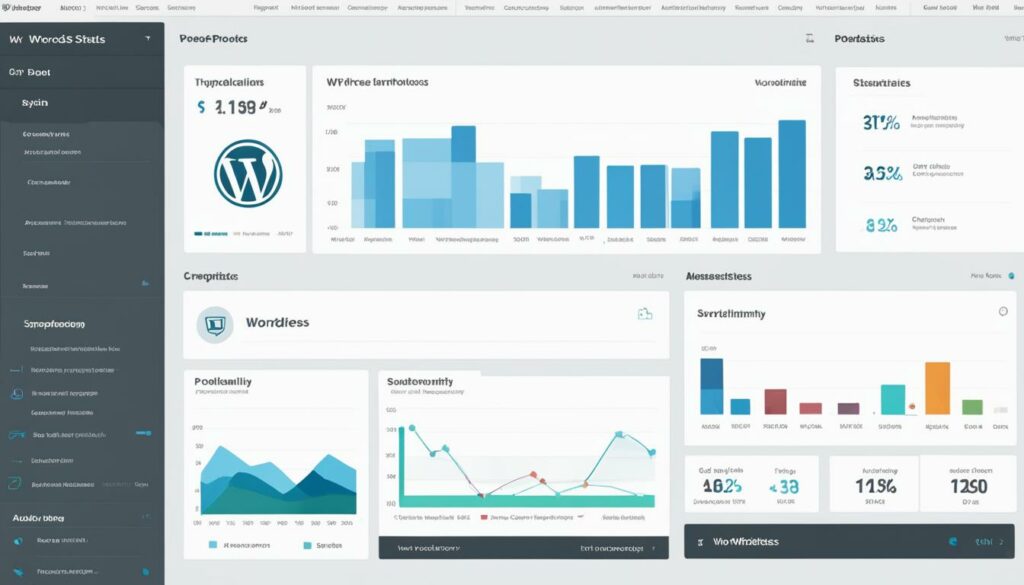When it comes to managing high-traffic websites, having a hosting infrastructure that can handle the load is crucial. Slow loading times not only frustrate visitors but can also have a negative impact on your business. To ensure optimal performance and a seamless user experience, it’s important to follow these hosting best practices.
Key Takeaways:
- Optimize your website’s load speed to meet visitor expectations
- Consider upgrading your hosting plan to handle high traffic
- Optimize your website design and content to improve page load times
- Leverage content delivery networks (CDNs) to distribute content and improve performance
- Implement compression techniques to reduce file sizes and improve load speeds
Understanding Visitor Expectations
When it comes to browsing the internet, users have one common expectation – fast loading times. In today’s fast-paced digital world, slow websites can lead to user dissatisfaction and decreased conversions. In fact, research shows that a mere one-second delay can result in a 7% loss in conversions and a 16% decrease in customer satisfaction. Slow loading times during high traffic periods can even lead to losing up to three-quarters of your visitors.
Meeting and exceeding visitor expectations by optimizing your website’s load speed is crucial. By ensuring fast loading times, you not only enhance user experience but also maximize your chances of conversions and retain your visitors.
So, how can you optimize your website’s load speed? Let’s take a closer look:
- Image Optimization: Compressing and optimizing images can significantly reduce file sizes and improve load times. Use the appropriate image format (JPEG, PNG, or GIF) and resize images to fit the dimensions they will be displayed in. Additionally, consider lazy loading techniques, which only load images as they are needed, improving the initial loading speed of your website.
- CSS and JavaScript Optimization: Minify and combine CSS and JavaScript files to reduce their sizes. By doing so, you can minimize the number of HTTP requests required for your website to load, resulting in faster load times.
- Eliminate Unnecessary Plugins: While plugins can add functionality to your website, too many of them can slow it down. Identify and remove any unnecessary plugins that are impacting your website’s performance.
- Mobile Optimization: With the majority of internet users accessing websites from mobile devices, optimize your website for mobile viewing. Ensure your site is responsive, loads quickly on mobile devices, and provides a seamless user experience.
Incorporating these optimization techniques into your website maintenance routine can help keep your high-traffic website running smoothly and efficiently.
“The need for fast loading times cannot be understated. Users demand speed, and slow websites can have a significant impact on your bottom line.” – Mark Johnson, Web Development Expert
By understanding and meeting visitor expectations for fast loading times, you can ensure a positive user experience and improve your website’s performance. The next section will explore the importance of upgrading your hosting to further optimize your high-traffic website.
Upgrading Hosting
When it comes to managing high-traffic websites, an essential step is to upgrade your hosting plan. Shared hosting, although suitable for small websites, may not provide the required bandwidth and performance capabilities to handle a large number of daily visitors. Additionally, shared hosting plans can be affected by the traffic load of other sites on the server, resulting in slower loading times and decreased user satisfaction.
To ensure optimal performance for your high-traffic website, consider upgrading to one of the following hosting options:
- VPS Hosting: A virtual private server (VPS) hosting plan offers more resources, control, and customization options compared to shared hosting. With a VPS plan, you have dedicated server-like capabilities while still sharing physical server space with other websites. This allows you to handle higher amounts of traffic and optimize performance according to your specific needs.
- Dedicated Server Hosting: If your website receives extremely high traffic volumes, a dedicated server hosting plan provides the ultimate performance and resources. With a dedicated server, you have an entire server dedicated solely to your website, ensuring maximum bandwidth, processing power, and control. This option is ideal for websites that require exceptional speed and reliability.
Additionally, for websites running content management systems like WordPress, managed hosting can be highly beneficial. Managed hosting providers offer specialized support for installation, updates, and server management, allowing you to focus on your website’s content and functionality.
Upgrading your hosting plan is a crucial step in optimizing your high-traffic website’s performance. It provides the necessary resources, scalability, and support to handle increased traffic volumes while ensuring a seamless user experience.
Benefits of Upgrading Hosting:
| Shared Hosting | VPS Hosting | Dedicated Server Hosting | Managed Hosting |
|---|---|---|---|
| Limited bandwidth and resources, susceptible to traffic load from other sites | Increased resources and customization options | Maximum bandwidth, processing power, and control | Specialized support for installation, updates, and management |
| Lower performance and potential downtime | Improved performance and scalability | Unparalleled speed and reliability | Efficient handling of CMS requirements |
| Less control and flexibility | Greater control over server settings | Complete autonomy over server customization | Focus on website content and functionality |
By upgrading your hosting plan, you can ensure that your high-traffic website has the necessary resources, performance capabilities, and support to handle increased traffic volumes effectively.
Optimizing Website Design and Content
When it comes to managing high-traffic websites, optimizing your website design and content is crucial for improving page load speed and overall website performance. By implementing specific techniques, you can ensure a seamless user experience for your visitors and increase your website’s efficiency.
Simplify Your Website Design
Simplifying your website design can have a significant impact on page load times, especially for websites with a large number of scripts or media elements. By reducing the complexity of your website’s design, you can minimize the amount of data that needs to be loaded, leading to faster load times and improved user experience.
Optimize Image and Script Sizes
To further enhance page load speed, it is important to optimize image and script sizes. Compressing images and using file formats that are optimized for the web, such as JPEG or PNG, can significantly reduce file sizes without compromising image quality. Additionally, optimizing script sizes by minifying JavaScript and CSS files can help streamline the loading process.
Set Specific Image Dimensions
Setting specific image dimensions allows the browser to allocate the necessary space for images, preventing layout shifts and optimizing the rendering process. By defining the width and height attributes for images, you can ensure that the browser can efficiently load and display them.
Combine CSS into One File
Combining CSS into a single file reduces the number of HTTP requests made by the browser, resulting in faster load times. By merging multiple CSS files into one, you can minimize the overhead associated with loading each individual file, improving the overall performance of your website.
Use Lazy Loading Techniques
Lazy loading is a technique that only loads specific elements when they are needed, rather than loading all content at once. By implementing lazy loading for images, videos, and other media elements, you can reduce the initial load time and allow users to start interacting with your website more quickly.
Minimize Plugin Use, Avoid Redirects, and Fix Broken Links
Plugins can add functionality to your website, but they can also slow down page load times. It is important to carefully evaluate and minimize the use of plugins, only keeping those that are essential. Additionally, avoiding unnecessary redirects and fixing broken links can significantly improve website performance and provide a smoother user experience.
Consider Mobile Users
Considering mobile users is essential as page speed is of utmost importance for mobile visitors. As more and more users access websites via mobile devices, optimizing your website design and content for mobile responsiveness and fast load times is crucial. With a responsive design and optimized content, you can ensure a positive user experience across all devices.
By implementing these website design and content optimization practices, you can enhance page load speed, improve overall website performance, and provide a seamless user experience for your high-traffic website.

| Technique | Benefits |
|---|---|
| Simplify website design | Improved page load times |
| Optimize image and script sizes | Faster load times, reduced bandwidth usage |
| Set specific image dimensions | Prevent layout shifts, optimize rendering |
| Combine CSS into one file | Reduced HTTP requests, faster load times |
| Use lazy loading techniques | Reduced initial load time, faster user interaction |
| Minimize plugin use | Improved performance, reduced page load times |
| Avoid redirects | Streamlined user experience, faster load times |
| Fix broken links | Improved website performance, enhanced user experience |
| Consider mobile users | Optimized page speed for mobile visitors |
Leveraging Content Delivery Networks (CDNs)
When it comes to improving your website’s performance and delivering content faster to your users, leveraging a Content Delivery Network (CDN) is a game-changer. CDNs distribute your website’s content across multiple servers located in different geographical locations. This strategic distribution reduces latency and ensures faster content delivery to users, regardless of their location.
By using a CDN, you can optimize website performance and provide a seamless user experience, even during high-traffic periods. CDNs have servers strategically placed around the world, which means that your content is closer to your users, resulting in reduced load times.
One of the key advantages of using a CDN is its ability to enhance website performance by caching content. When a user accesses your website, the CDN serves the cached content from the server closest to them. This reduces the round-trip time required to load content, resulting in faster load times and improved website performance.
Moreover, CDNs offer additional security and protection against Distributed Denial of Service (DDoS) attacks. They act as a shield, protecting your website and ensuring its availability, even during unexpected traffic surges or malicious attacks.
To maximize the benefits of a CDN, it’s important to choose a provider with servers located in the areas where the majority of your visitors come from. This allows for even faster content delivery and enhanced performance, specifically tailored for your target audience.
Benefits of Leveraging CDNs:
- Reduced latency and faster content delivery
- Optimized website performance during high-traffic periods
- Enhanced user experience with faster load times
- Added security and protection against DDoS attacks
Case Study: Increasing Website Performance with CDN
Let’s take a look at a real-life example of how leveraging a CDN transformed website performance for a popular e-commerce website. The website, which sells fashion apparel, experienced slow load times and high bounce rates during peak hours, affecting their overall revenue.
By implementing a CDN, the website managed to distribute content across various servers, reducing latency and improving loading times for users. As a result, the website’s bounce rate decreased by 30%, and the average load time reduced by 50%, leading to improved user engagement and conversion rates.
Implementing a CDN not only significantly improved website performance but also helped the e-commerce website maintain a competitive edge in the market by providing an exceptional user experience.

With the help of a CDN, your website can deliver content faster, provide a better user experience, and boost overall website performance. By optimizing content delivery, you can ensure that your website remains accessible and responsive, regardless of the traffic volume or user location.
Implementing Compression Techniques
When it comes to optimizing your website’s performance, implementing compression techniques is crucial. By reducing file sizes and optimizing content, you can significantly improve load speeds and enhance the overall user experience. In this section, we’ll explore various compression techniques such as file compression, Gzip compression, image and script optimization, and more.
1. File Compression
File compression, such as Gzip compression, is a widely used technique to shrink file sizes and reduce bandwidth usage. By compressing files before they are sent to the user’s browser, you can minimize transfer times and improve load speeds. Gzip compression works by identifying repetitive patterns within a file and replacing them with shorter representations. This compression method is compatible with most web browsers and servers, making it an effective solution for optimizing website performance.
2. Image Optimization
Images are often one of the largest elements on a web page, and optimizing them can significantly impact load times. By compressing images without sacrificing quality, you can reduce their file sizes and enhance website performance. Tools like CSS compressors and image optimizers can be used to automate this process, making it easier to optimize multiple images. Additionally, setting specific image dimensions and using responsive design techniques can further optimize image loading.
3. Script Optimization
Scripts, such as JavaScript and CSS files, can also contribute to slow load times if they are not optimized. Minifying these files by removing unnecessary characters, whitespace, and comments can help reduce their sizes and improve loading speeds. Combining multiple CSS files into one and placing JavaScript files at the bottom of the HTML document can further optimize the loading process. By minimizing the script sizes and reducing the number of requests, you can enhance overall website performance.
Implementing these compression techniques can have a significant impact on your website’s load speeds, resulting in improved user experience and higher visitor engagement. By reducing file sizes, minimizing bandwidth usage, and optimizing content, you can ensure that your website performs at its best even during high-traffic periods.
“Implementing compression techniques, such as file compression, Gzip compression, and image/script optimization, is essential for enhancing website performance and providing a seamless user experience.”

| Compression Technique | Benefits |
|---|---|
| File Compression (Gzip) | Reduces file sizes and bandwidth usage |
| Image Optimization | Minimizes image file sizes without sacrificing quality |
| Script Optimization | Minifies JavaScript and CSS files, reduces requests |
By utilizing these compression techniques, you can optimize your website’s performance, improve load speeds, and ultimately provide a better user experience. It is important to regularly monitor and test your website’s performance to ensure that these optimization techniques are effectively implemented and delivering the desired results.
Conclusion
Managing high-traffic websites requires a comprehensive approach that encompasses various aspects of hosting infrastructure and website optimization. By implementing best practices in these areas, you can ensure that your website can handle the load and provide a seamless user experience for your valuable visitors.
Proper selection of hosting plans is crucial for high-traffic websites. Upgrading from shared hosting to VPS hosting or dedicated server hosting can provide you with the necessary resources and performance capabilities to handle large numbers of daily visitors. Additionally, consider managed hosting services for efficient installation, updates, and server management, especially for popular content management systems like WordPress.
Optimizing your website design and content plays a vital role in improving page load speed. Simplify your design, optimize image and script sizes, combine CSS into one file, and minimize the use of plugins. It is also essential to consider mobile users and ensure that your website is optimized for fast loading on mobile devices.
Leveraging content delivery networks (CDNs) can significantly enhance your website’s performance. By distributing content across multiple servers located in different geographical locations, CDNs reduce latency and improve content delivery. Additionally, implementing compression techniques, such as Gzip compression, and optimizing images and scripts help reduce file sizes and further improve load speeds.
Regularly monitoring your website’s performance is essential to identify and address any issues promptly. By staying proactive, you can maintain optimal performance, visitor satisfaction, and prevent loss of revenue. Remember that managing high-traffic websites is an ongoing process, and by following these best practices, you can create a robust and successful online presence.
FAQ
Q: Can shared hosting plans handle high-traffic websites effectively?
A: No, shared hosting plans lack the necessary bandwidth and can be affected by the traffic load of other sites on the server. Upgrading to a VPS hosting or dedicated server hosting plan is recommended for high-traffic websites.
Q: What is the advantage of VPS hosting and dedicated server hosting for high-traffic websites?
A: VPS hosting and dedicated server hosting provide more resources and performance capabilities, allowing for scalability and customization to meet the needs of high-traffic websites.
Q: Are managed hosting services suitable for high-traffic websites?
A: Yes, managed hosting services, especially for content management systems like WordPress, can provide support for installation, updates, and server management.
Q: How can I optimize my website design to improve page load times?
A: Simplify your website design, optimize image and script sizes, set specific image dimensions, combine CSS into one file, use lazy loading techniques, minimize plugin use, avoid redirects, and fix broken links.
Q: What is a content delivery network (CDN) and how can it improve website performance?
A: A CDN is a network of servers located in various geographical locations. It distributes website content, reducing latency, and ensuring faster content delivery to users regardless of their location.
Q: How can file compression techniques optimize website content?
A: File compression, such as Gzip compression, reduces file sizes and improves load speeds. Compress images, minify JavaScript and CSS files, and use tools like CSS compressors and image optimizers to further optimize website content.
Q: What should I do to manage a high-traffic website effectively?
A: To manage a high-traffic website effectively, follow best practices in hosting infrastructure, visitor expectations, website optimization, content delivery networks, compression techniques, and monitoring website performance.











